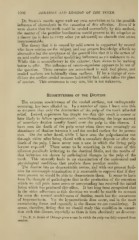Page 996 - My FlipBook
P. 996
1006 ABRASION AND EROSION OF THE TEETH.
Dr. Swain's results agree with my own conviction as to the possible
influence of electrolysis in the causation of this affection. Even if it
were shown that the teeth could be eroded successfully by this method,
the matter of the peculiar localization would present to its adoption as
a theory (as it does to every other yet advanced) an obstacle that seems
insurmountable.
The theory that it is caused by acid mucus is supported by several
who have written on the subject, and our present knowledge affords no
alternative but the acceptance of the general idea that it is the action of
an acid under some peculiar modifying influences as yet unknown to us.
While this is unsatisfactory in the extreme, there seems to be nothing
better to offer. The influence of micro-organisms appears to be out of
the question. These enemies are accustomed to seek foul places, and
eroded surfaces are habitually clean surfaces. If by a change of con-
ditions the surface eroded becomes habitually foul, caries takes the place
of erosion. This occurrence is very rare, but is not unknown.
Sensitiveness of the Dentine.
The extreme sensitiveness of the eroded surfaces, not unfrequently
occurring, has been alluded to. In a number of cases I have seen this
so extreme that only the destruction of the pulp of the tooth afforded
relief. Indeed, experience has taught me that this result is sooner or
•
later likely to follow spontaneously, notwithstanding the large amount
of secondary dentine usually found over the pulp in this disease. I
have seen the death of the pulp occur when there was seemingly an
abundance of dentine between it and the eroded surface for its protec-
tion. On the other hand, while I have seen the pulp-chamber cut
through eitlier after being closed with a secondary deposit or after the
death of the pulp, I have never seen a case in which the living pulp
became exposed.' There seems to be something in the cause of this
affection peculiarly irritating to the dentinal fibrils, and the results of
that irritation are shown by pathological changes in the pulp of the
tooth. This naturally leads to an examination of the anatomical and
physiological conditions that produce these peculiar results.
The dentine has no demonstrable nerves, and with our present facil-
ities for microscopic examination it is reasonable to suppose that if they
were present we -would bo able to demonstrate them. It seems to have
been the thought of pathologists that in the production of the sensation
which we call 'pain some nerve or nerve-ending has received the initial
lesion which has produced this effect. It has long been recognized that
in the strict adherence to this doctrine we would be unable to account
for even the normal sensitiveness of dentine, much less the occurrence
of hypersesthesia. Yet the hyperaesthesia does occur, and in the most
excruciating forms, and especially in the disease we are considering. It
seems, therefore, fitting that we should study this condition in connec-
tion with this disease, especially as there is here absolutely no discover-
' Dr. E. D. Swain of Chicago gives a case in which the pulp was fully exposed from
erosion.


